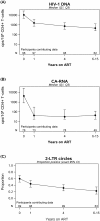Levels of HIV-1 persistence on antiretroviral therapy are not associated with markers of inflammation or activation
- PMID: 28426825
- PMCID: PMC5398724
- DOI: 10.1371/journal.ppat.1006285
Levels of HIV-1 persistence on antiretroviral therapy are not associated with markers of inflammation or activation
Abstract
Antiretroviral therapy (ART) reduces levels of HIV-1 and immune activation but both can persist despite clinically effective ART. The relationships among pre-ART and on-ART levels of HIV-1 and activation are incompletely understood, in part because prior studies have been small or cross-sectional. To address these limitations, we evaluated measures of HIV-1 persistence, inflammation, T cell activation and T cell cycling in a longitudinal cohort of 101 participants who initiated ART and had well-documented sustained suppression of plasma viremia for a median of 7 years. During the first 4 years following ART initiation, HIV-1 DNA declined by 15-fold (93%) whereas cell-associated HIV-1 RNA (CA-RNA) fell 525-fold (>99%). Thereafter, HIV-1 DNA levels continued to decline slowly (5% per year) with a half-life of 13 years. Participants who had higher HIV-1 DNA and CA-RNA before starting treatment had higher levels while on ART, despite suppression of plasma viremia for many years. Markers of inflammation and T cell activation were associated with plasma HIV-1 RNA levels before ART was initiated but there were no consistent associations between these markers and HIV-1 DNA or CA-RNA during long-term ART, suggesting that HIV-1 persistence is not driving or driven by inflammation or activation. Higher levels of inflammation, T cell activation and cycling before ART were associated with higher levels during ART, indicating that immunologic events that occurred well before ART initiation had long-lasting effects despite sustained virologic suppression. These findings should stimulate studies of viral and host factors that affect virologic, inflammatory and immunologic set points prior to ART initiation and should inform the design of strategies to reduce HIV-1 reservoirs and dampen immune activation that persists despite ART.
Conflict of interest statement
I have read the journal's policy and the authors of this manuscript have the following competing interests: EH is employed by a commercial company, Social & Scientific Systems, Inc. JJE is a consultant to Gilead Sciences, Merck & Co, Janssen and ViiV Healthcare. The University of North Carolina receives research grants from Gilead Sciences, Janssen and ViiV Healthcare on which JJE is an investigator. ACC is a member of a Data Safety and Monitoring Board for Merck & Co.-sponsored studies and received support from the International AIDS Society-USA for preparation of an educational presentation. JWM is a consultant for Gilead Sciences and a shareholder of Cocrystal Pharma, Inc.
Figures







References
-
- Finzi D, Hermankova M, Pierson T, Carruth LM, Buck C, Chaisson RE, et al. Identification of a reservoir for HIV-1 in patients on highly active antiretroviral therapy. Science. 1997;278(5341):1295–300. - PubMed
MeSH terms
Substances
Grants and funding
LinkOut - more resources
Full Text Sources
Other Literature Sources
Medical

